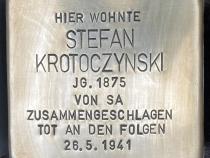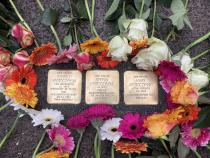Stefan Krotoczynski (1875-1941) was born in Kleczew, Poland, which was under Russian control at that time. Both his father, Joseph Krotoczynski (1824-1880) and his mother, Ruda (1840-1930) née Buki, were also born in Kleczew. Stefan had five half siblings from his father’s previous marriage who emigrated to Macon, Georgia in America during the late 19th Century. Ruda also bore him five children, including Stefan, his two brothers, Charlie and Sally, and two sisters, Rosa and Malka. Stefan and his brother Charlie joined their half-siblings to start a new life in America at the turn of the century, and then both returned to Europe to settle in London, England, where they were granted citizenship.
Stefan Krotoczynski was a tailor by trade and also served as a cantor, having been trained as such as a young man in Poland. In 1912, Stefan left England for Germany to join his mother and three full siblings in Strasburg, Mecklenburg. He married his first wife, Jenny Krotoczynski, née Flasch (1869-1918), and settled in Friedland, Mecklenburg. Jenny died of stomach cancer and was buried in the Jewish Cemetery in Friedland. He was then introduced to his second wife, Gertrud Silberstein, through his brother’s business connections in Berlin. After their marriage in 1921, Gertrud became pregnant and gave birth to their only child, Mary, on July 28, 1922.
Stefan, Gertrud, and their daughter, Mary, lived in Friedland for six years where he had a tailor shop and served as a cantor for synagogues in Neubrandenburg. He and his family then moved to nearby Strasburg to live with his mother and siblings after his business failed. A year later, in 1930, the family moved to Berlin where Gertrud’s relatives lived. By this time, Stefan was 55 years old and suffering from a heart condition. With help from relatives and work as a cantor, he and Gertrud managed to make ends meet. When the Nazi persecution of Jews increased, Stefan contacted relatives in the United States who proved willing to sponsor his family’s immigration to the U.S. However, he was unable to obtain visas for his family, so he arranged to have Mary leave Berlin on a Kindertransport to live with family connections in London. After Mary left, Stefan was beaten by Nazi thugs and later on died of a heart attack on May 26, 1941. He was buried in the Jewish Cemetery in Berlin-Weissensee, where his wife’s parents were also buried. Gertrud was deported to Riga six months later in December 1941 and murdered there.




